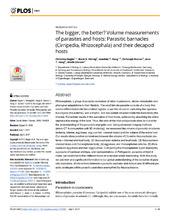| dc.contributor.author | Nagler, Christina | |
| dc.contributor.author | Hornig, Marie K | |
| dc.contributor.author | Haug, Joachim T | |
| dc.contributor.author | Noever, Christoph | |
| dc.contributor.author | Høeg, Jens T. | |
| dc.contributor.author | Glenner, Henrik | |
| dc.date.accessioned | 2018-08-14T12:25:26Z | |
| dc.date.available | 2018-08-14T12:25:26Z | |
| dc.date.issued | 2017-07-05 | |
| dc.Published | Nagler C, Hornig MK, Haug JT, Noever C, Høeg JT, Glenner H. The bigger, the better? Volume measurements of parasites and hosts: Parasitic barnacles (Cirripedia, Rhizocephala) and their decapod hosts. PLoS ONE. 2017;12(7):e0179958 | eng |
| dc.identifier.issn | 1932-6203 | en_US |
| dc.identifier.uri | https://hdl.handle.net/1956/18078 | |
| dc.description.abstract | Rhizocephala, a group of parasitic castrators of other crustaceans, shows remarkable morphological adaptations to their lifestyle. The adult female parasite consists of a body that can be differentiated into two distinct regions: a sac-like structure containing the reproductive organs (the externa), and a trophic, root like system situated inside the hosts body (the interna). Parasitism results in the castration of their hosts, achieved by absorbing the entire reproductive energy of the host. Thus, the ratio of the host and parasite sizes is crucial for the understanding of the parasite’s energetic cost. Using advanced imaging methods (micro-CT in conjunction with 3D modeling), we measured the volume of parasitic structures (externa, interna, egg mass, egg number, visceral mass) and the volume of the entire host. Our results show positive correlations between the volume of (1) entire rhizocephalan (externa + interna) and host body, (2) rhizocephalan externa and host body, (3) rhizocephalan visceral mass and rhizocephalan body, (4) egg mass and rhizocephalan externa, (5) rhizocephalan egg mass and their egg number. Comparing the rhizocephalan Sylon hippolytes, a parasite of caridean shrimps, and representatives of Peltogaster, parasites of hermit crabs, we could match their different traits on a reconstructed relationship. With this study we add new and significant information to our global understanding of the evolution of parasitic castrators, of interactions between a parasitic castrator and its host and of different parasitic strategies within parasitic castrators exemplified by rhizocephalans. | en_US |
| dc.language.iso | eng | eng |
| dc.publisher | PLoS | en_US |
| dc.rights | Attribution CC BY | eng |
| dc.rights.uri | http://creativecommons.org/licenses/by/4.0 | eng |
| dc.title | The bigger, the better? Volume measurements of parasites and hosts: Parasitic barnacles (Cirripedia, Rhizocephala) and their decapod hosts | en_US |
| dc.type | Peer reviewed | |
| dc.type | Journal article | |
| dc.date.updated | 2018-03-06T12:25:18Z | |
| dc.description.version | publishedVersion | en_US |
| dc.rights.holder | Copyright 2017 The Author(s) | en_US |
| dc.identifier.doi | https://doi.org/10.1371/journal.pone.0179958 | |
| dc.identifier.cristin | 1525355 | |
| dc.source.journal | PLoS ONE | |

